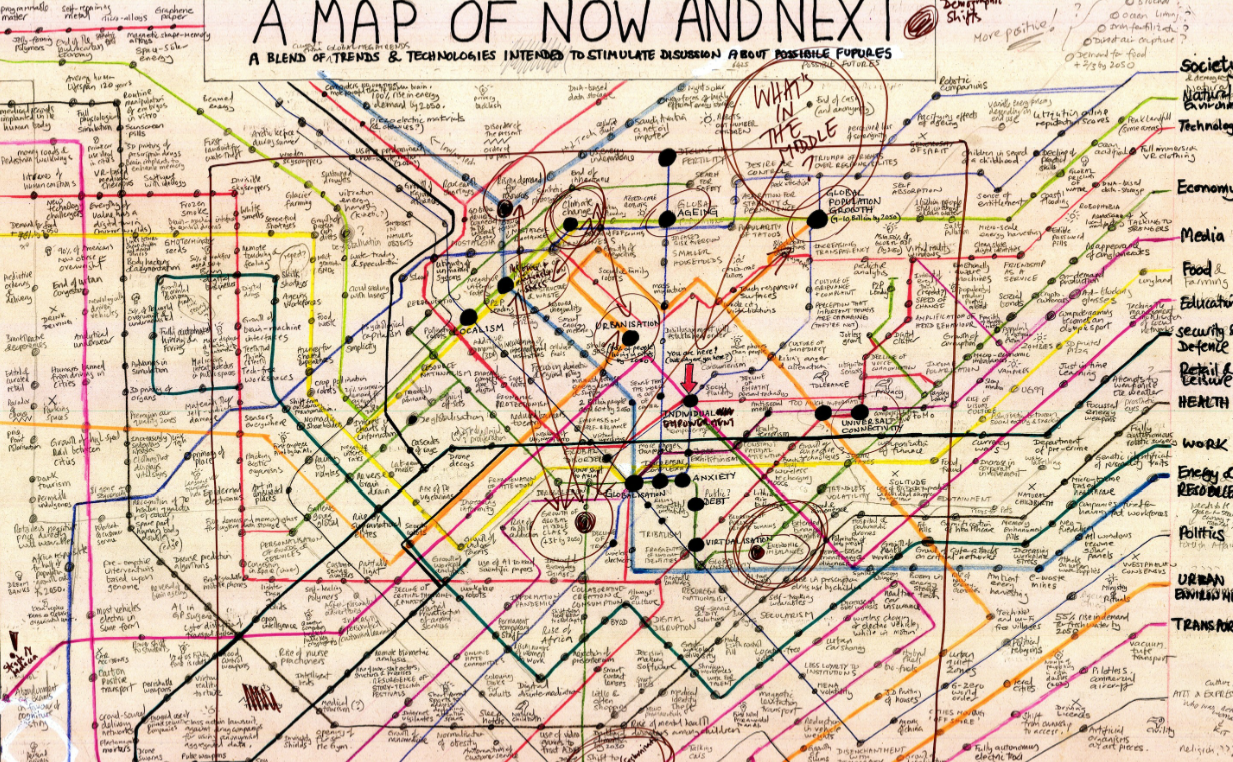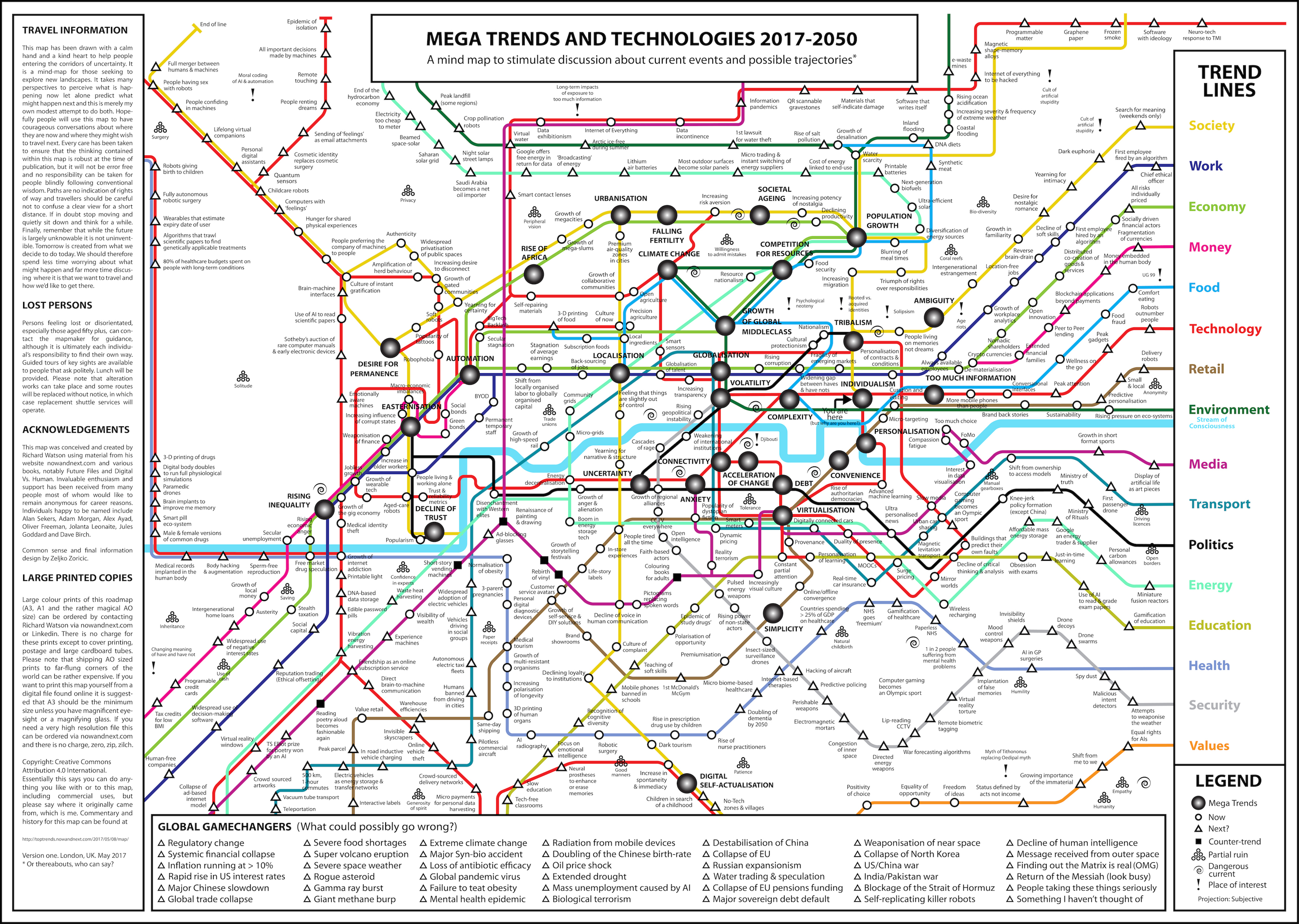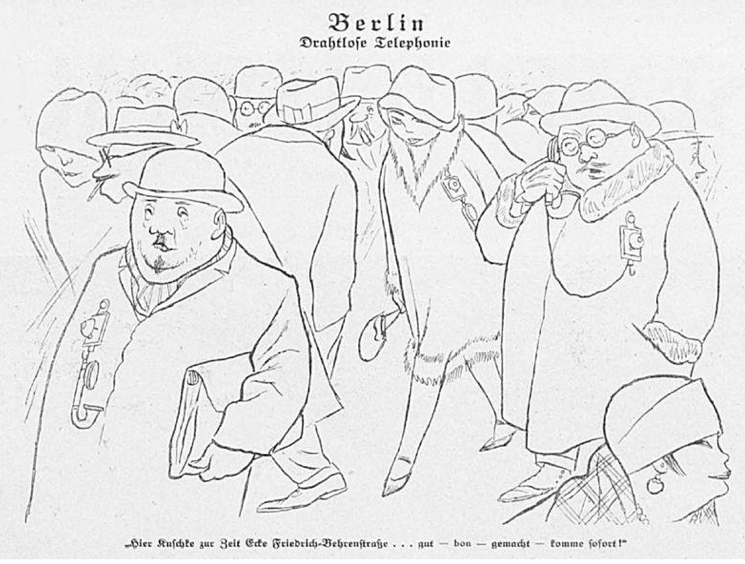Here you go then. Use this link to get to a high resolution version. A3, A1 and rather wonderful AO sized copies on paper are available upon request (no charge except for print, post and a cardbaord tube). See you in the future.
Category Archives: Trends
2017 Trends & Ideas
Continuance of volatility, confusion, ambiguity and uncertainty
We’ve moved from a G-7 world order dominated by the US to a G-Zero world with no clear super-power. The resultant vacuum is being fought over by just about everyone, including an assortment of nutcases and crackpots. We shouldn’t discount the ability of the US (or perhaps China) to re-stabilise the system, but having removed balance and added hyper-connectivity things are likely to get more unstable and uncertain, not less.
Growth of dystopian sci-fi to counter (or at least dilute) the above
Good Science fiction has always been about contemporary concerns. While there’s not much geo-political sci-fi around there’s plenty concerning our anxieties around automation, robotics, super-humans and immortality. Is it too much of a stretch to link the Zombie genre with ageing societies? – probably. I also quite like the idea that the vampire genre can be read as a metaphysical rendition of the impact of connectivity addiction and information overload.
Growth of the Internet of (everyday) Things, especially smart sensors
We’ve been connecting information and then ourselves to the Internet for a while, but we’re now connecting ‘things’, which produces information, sometimes useful, sometimes not. In theory this should result in huge efficiencies and the ability to predict exactly what people (and things) need.
But it could also result in an enlarged ‘attack surface’ for people intent on causing havoc along with significant breaches of privacy and data theft.(See first trend – volatility and confusion).
Growth of Virtual Reality and entry into business applications
It’s still a bit early to call this one (remember Google Glass?), but it does look as though VR (and AR) could be the next big thing until we get bored at search for the next next big thing. Initial applications will be gaming and possibly ‘adult entertainment’, but it should bleed into security, retail, education and health among other areas.
Emergence of hybrid or mixed reality environments in retail
When retail isn’t about convenience or price it’s about experiences. So VR, AR and mixes of both (along with injections of highly sensual reality) are were retail will go. Retail will thus likely polarise between quick and easy (and cheap) and highly sensory experiences.
Continuation of cyber-attack attempts on critical infrastructure
Could there ever be a digital pearl harbour? We’re half expecting it, so possibly not. Nevertheless, the amount of damage that can be done to our ever expanding and hugely interlinked systems is immense. With this in mind I’d expect some kind of ‘Balkanisation’ of the Internet with what was once an open global system being replaced by smaller units each with varying degrees of local control and interference. BTW, if this worries you always have a back up that’s not digital and isn’t digitally or remotely controlled.
Growth of nationalism/protectionism and to a degree isolationism
The more the world becomes global and homogenised the more that cultural identity comes to the fore. We saw this with Brexit where identity (and to some extent sovereignty) trumped economics. We slightly saw it with Trump too when the threat of rising powers and disappearing influence and employment created a turning inwards and backwards. Trump and Brexit were also about a popular revolt against elites, but the bottom line remains the same. You might link tribalism being fuelled by the internet, resources being put under pressure by climate change and population growth, but whatever you include the end result is much the same. Fear is making nations (and people) turn inward and backward.
Digital services added to physical products (mirror worlds)
A mirror world is an old sci-fi idea where everything that exists in one domain has a twin somewhere else. This is where VR, AR and the IoT are taking us. This is a world where everything of significance or substance has a digital equivalent containing useful information about its origins, location or state.
Voice interfaces becoming more mainstream (e.g. Amazon Echo)
Goodbye keyboards, computer mice and even touch screens. The future seems to involve humans taking to machines to control them and the machines taking back. Ironic, don’t you think, given that humans don’t really talk to each other anymore, preferring to type or tap on screens instead.
Emotionally aware machines and conversational computers (See above)
As above, but the machines can now figure out what mood you’re in and respond or reconfigure themselves accordingly. If you want to know where this could go watch the movie Her or tune into Black Mirror on TV.Links with virtual assistants.
3D printed food gets discussed, but generally disgusts
OK, so NASA is doing experiments printing food for far-flung missions. Pizza and cookies aren’t too bad apparently. But we’re not stuck in space and humans are deeply sensory. Food is creative and social too, so this idea leaves a nasty taste in the mouth. Having said this I can imagine 3D-printed food being a fun thing to use in certain retail and leisure environments.
Wireless charging pads in workplace, home and retail environments
Putting aside my cynicism that we’ll ever build a true IoT or smart city when we’ve been totally incapable of creating a universal charging cable for digital devices, wires are still a pain. So perhaps charging plates for phones in Starbucks are a good idea. Or how about charging plates in the ground under parking spaces so that your electric car wirelessly re-charges when it’s parked. This could catch on.
Next generation of fast charging batteries competes with the above
OK, so my iPhone5 (I know, I know!) has more computing power than an early NASA mission, but the battery hardly lasts a day. My festival phone (a Nokia 105) lasts a week. Clearly what we need are batteries that last a whole lot longer and/or fast charging. Expect both to appear in 2017.
Sunscreen pills appear, but nobody trusts them
Now a male contraceptive pill that also prevents sunstroke would be a good idea….maybe. Maybe not.
Portable laser pens to treat minor wounds (e.g. on battlefields)
This one is pure Star Trek, but it’s also almost here. It’s healthcare Jim, but not as we know it.
Growth of the virtual economy (e.g. people paying to ‘see’ virtual bands)
This one is really interesting. On the one hand the success of live music and the renaissance of vinyl surely shows that people sometimes like the ‘real thing’. But then when people spend a whole concert watching the concert through their phone screen what’s the point? Why not just watch the whole thing on a giant TV. Or, perhaps, the future is a mixed reality where people show up at a stadium ‘in person’ but watch a VR or holographic band. The possibilities are mind-boggling. Artists could play ‘live’ in more than one stadium at once or you could watch ‘dead bands’ like Abba ‘live’.
Software than can write itself
Software can take an age to write, so why not write software than can write itself?
Prosthetic limbs with a sense of touch
Mixed reality again? It’s getting somewhat confusing. And let’s not even delve into the possibilities for virtual or remote sex.
Blockchain applications beyond payments
I still don’t understand Blockchain, but apparently this is going to be a big thing
Epidemic of ‘study drugs’ in UK and US universities
Cognitive enhancement is becoming something of an epidemic in higher education – so called ‘study drugs’. This is a symptom of global hyper-competition and our relentless pursuit of productivity. Ritalin, Adderall and Dexedrine – all attention deficit drugs – are being used to create focus and task motivation (i.e. make really dull things seem interesting). And guess what? They are all coming to the workplace soon – an update, if you will, of strong cups of coffee, cigarettes and Red Bull.
Continuation of energy decentralisation
The days of national grids are fading. Local energy networks where users are also producers and distributers are becoming more mainstream. Expect Google to enter the energy market as a trader and/or supplier.
Apple either announce an iCar or an iLock
Just a thought. The iCar has been expected for a while. I wrote about it ten years ago in fact. A physical padlock that is digitally operated would be kinda cool too.
Resurgence of craft and analogue products
Most strong trends create counter-trends, so as the world becomes more automated, accelerated and virtual there will be pockets of resistance in the form of locally made craft products and slow services.
Back-lash against digital privacy invasions
See the IoT, smart sensors and alike. Remember this is your data they’re using.
Like the man says: If something is free on the internet, you are quite often the product.
Back-lash against Big Tech
This is partly a story about wealth, income and opportunity polarisation. It’s partly one about tax evasion, the avoidance of regulation and various ethical and moral responsibilities. And it’s partly one about privacy and whose data they are using.
…I’ll add links for all these trends and ideas over the coming week or so.
Trends for 2017
 I’m taking to the BBC tomorrow about trends for 2017 and here are my top of my head thoughts. I may develop these on this blog, add to them, remove a few…although they all feature strongly on my new mega-trends map.
I’m taking to the BBC tomorrow about trends for 2017 and here are my top of my head thoughts. I may develop these on this blog, add to them, remove a few…although they all feature strongly on my new mega-trends map.
Continuance of volatility, confusion, ambiguity and uncertainty
Growth of dystopic sci-fi to counter or at least dilute the above
Growth of the internet of (everyday) things, especially smart sensors and controls
Growth of Augmented Reality and entry into business applications
Emergence of mixed reality (Augmented + virtual + real)
Continuation of cyber-attacks
Growth of nationalism/protectionism and to a degree isolationism
Digital services added to physical products (mirror worlds)
Voice interfaces and conversational computers (e.g. Amazon Echo)
Growth of emotionally aware machines (affective computing – close to the above)
Back-lash against Big Tech
Relationships between science and fiction
Still working through whether or not there might be a good graphic in the linkages between scientific fact and speculative fiction. In this vein, came across this today, which is one of the best things I’ve read about trends and counter-trends, especially with regard to technology. Full article from the Guardian here.
“It’s always wrong to extrapolate by straightforwardly following a curve up,” he (Kim Stanley Robinson, a sci-fi writer) explains, “because it tends off towards infinity and physical impossibility. So it’s much better to use the logistic curve, which is basically an S curve.” Like the adoption of mobile phones, or rabbit populations on an island, things tend to start slowly, work up a head of steam and then reach some kind of saturation point, a natural limit to the system. According to Robinson, science and technology themselves are no exception, making this gradual increase and decrease in the speed of change the “likeliest way to predict the future”.
“We might be in a very steep moment of technological and historical change, but that doesn’t mean that it will stay that steep or even accelerate.” Practical and theoretical constraints, which go beyond even problems such as climate change with which we’re struggling now, will eventually slow us down, Robinson continues. “What I’m assuming is that there are some fundamental issues that are going to keep us from doing things much more spectacularly than we are now.”


